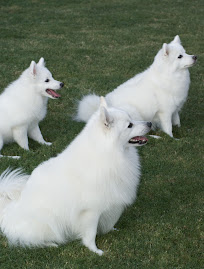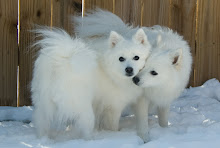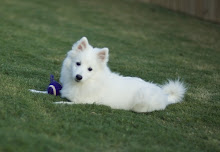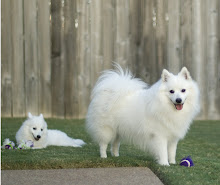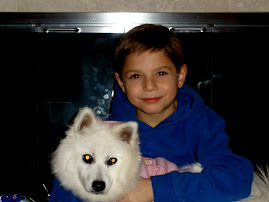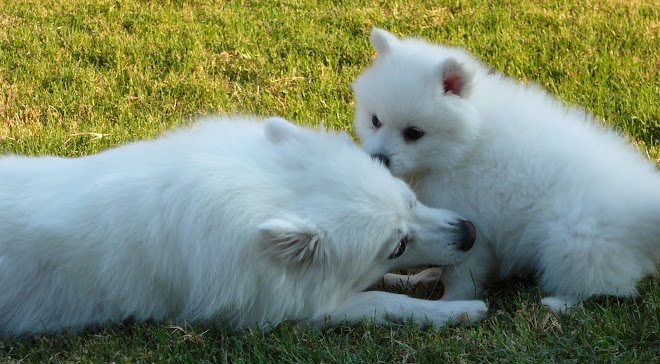Ruff Ruff Yogurt Pops
I recently found a recipe for a frozen summertime sweet treat that our dogs absolutely love. The recipe is from Annie Siegmann, owner of Ruff Ruff Bakery in Playa Del Ray, California.
RUFF RUFF YOGURT POPS
32 ounces vanilla or plain yogurt
1 - 2 ripe bananas (or 1/2 lb frozen cherries or blueberries)
2 tablespoons peanut butter
2 tablespoons honey (optional)
1 teaspoon cinnamon
1 teaspoon pure vanilla extract (optional)
Mash bananas, then mix in the remaining ingredients. Spoon mixture into an ice cube tray and freeze. Place one or two cubes in your dog's bowl for her to lick.
This is a great way to help your fluffy friend to cool down this summer!
TEACHING BASIC COMMANDS – ENTRY #7 (Combining Commands)
As you and your dog continue to progress together in your basic training, you will need to begin combining some commands. For example, some puppies, when learning the "Down" command, might forget how to "Sit". This is often caused by mistakes made by you, the trainer. The natural progression is to use the command "Down" immediately after the "Sit" command. If you do this too often, your dog will start to anticipate your next command.
There are two ways you can prevent this from happening. First, keep practicing the individual commands, as well as the combined commands. Second, when combining commands, mix and match the commands that you use. In other words, instead of always asking for a "Down" after asking for a "Sit", sometimes ask your dog to "Shake" after a "Sit". You could also ask your dog for a "Down" first, and then ask for a "Sit".
If you ask your little guy for one command and he gives you another (you ask for "Sit" and he gives you a "Down"), don't reward him. Instead, lure him back into position for the command you gave. Then reward him.
Combining "Come" with "Sit" is a good way to avoid some potential problems. You don't want your dog to come running to you only to jump up on you with muddy paws. Or, even worse, snatch the treat out of your hand and run away. If you've been consistently working with your dog (practicing at least 15 minutes per day with one new command per week), he should reliably sit and/or come when called nearly every time. To combine these two commands, just follow these steps:
- You should be in a standing position.
- Say your dog's name followed by the command "Come". (Use the same technique you learned when first teaching the "Come" command.
- Next, cue your puppy to sit with either the verbal command or the hand signal.
- Reward the behavior by giving your puppy a treat.
Wait a few seconds before you give your pooch a treat. You want him to stay sitting in front of you until you tell him differently. It won't take long before your puppy will automatically sit each time he comes to you.
As discussed many times in this series, it is important to make the training fun for your dog. One way you can do this is by turning the training session into a game. Our dogs love to play hide and seek. We play this game by combining three basic commands - "Sit", "Stay" and "Come". First, I put the dogs in a "Sit-Stay" position. Then I will hide somewhere in the house. Once I find a hiding spot, I yell out the word "Come". The dogs will run around the house trying to find me. Once they succeed in finding me, I reward them with a treat. Be sure to keep the game challenging - hide in various parts of the house. The better your dogs become at the game, the more challenging your hiding place can be. Geisha, Sami & Ju-Ju absolutely love this game and never seem to tire of it.
As you can imagine, there are many advantages to combining and practicing commands. After all, practice makes perfect. Keep it up and pretty soon, you'll have another happy and well-mannered addition to your family.
FIRST AID IN THE FIELD (Entry #4 - "Heatstroke")
When it occurs: Dogs can fall victim to heatstroke for a number of reasons, including prolonged exposure to hot weather, activity in humid climates, being left in vehicles with rising temperatures and insufficient water consumption.
What experts say about prevention: To keep your dog from experiencing heatstroke, use good judgment and carry plenty of water. It is a good idea to carry just as much water for each of your dogs as you do for yourself. If in a heated environment or a situation such as one noted above, make sure your dogs drink water every 15 - 20 minutes. You can also use the water to cool your dogs down by pouring it over their heads and down their backs.
How serious is it? Heatstroke is a serious condition that can be fatal. It is estimated that two out of every twelve dogs that suffer from heatstroke will die.
How to treat the condition: If your dog is suffering from heatstroke, you'll notice it panting heavily. It may become wobbly while walking and unresponsive. Some dogs vomit and become unconscious. Before seeking medical treatment, first cool your dog down. Keep your dog in the shade and wet it down with water until its temperature reaches 103 degrees Fahrenheit.
Give your dog frequent, small sips of water. A commonly recommended amount is one pint per 50 pounds of body weight in 30 minutes to avoid vomiting and vascular disease due to overhydration, withholding water only if your dog vomits.
If your dog has not recovered within an hour, take it to a veterinarian immediately. Check that its lips and gums look normal. Your dog has recovered when its temperature, respiration, gait and alertness have returned to normal.
* The above information courtesy of DogWorld Magazine - April, 2009
CARING FOR YOUR SENIOR (Entry #1 - "Emergency Signs")
The oldest dog in our home is BlackJacks, our lovable 15 year old black Labrador. Seven years ago he crossed over into canine seniorhood. Senior dogs require a different kind of care than younger dogs and it is important to maintain regular veterinary checkups. An older dog is more likely to develop illnesses, injuries and other age-related health problems such as diabetes, kidney failure and arthritis.
 It may be a little harder to know when to seek immediate veterinary care for your senior dog. Be sure to watch for changes in his/her activity level, eating or drinking habits, breathing, and behavior. These could be indications of problems above and beyond normal aging, including diabetes, liver failure, hypothyroidism and Cushing's disease. Lisa Hanks, writer for DogWorld magazine provides the following list of symptoms to look out for:
It may be a little harder to know when to seek immediate veterinary care for your senior dog. Be sure to watch for changes in his/her activity level, eating or drinking habits, breathing, and behavior. These could be indications of problems above and beyond normal aging, including diabetes, liver failure, hypothyroidism and Cushing's disease. Lisa Hanks, writer for DogWorld magazine provides the following list of symptoms to look out for:- Blood in feces or urine
- Collapsing or sudden weakness
- Confusion
- Coughing after activity
- Difficulty eliminating or urinating
- Elimination problems, such as diarrhea or accidents, lasting for more than 24 hours
- Excessive panting
- Excessive thirst
- Failure to eat
- Hair loss or persistent skin sores
- Hearing loss
- Increased eating without weight gain
- Increased lethargy or naps
- Lameness lasting more than five days
- Personality changes
- Retreating from family activities
- Seizures
- Staggering or lack of coordination
- Sudden blindness or vision loss
- Sudden change in urination or urine leakage
- Sudden weight loss or gain
- Vomiting that lasts more than 24 hours
If you think something is off, it is much better to contact your vet rather than doing nothing or trying to "wait it out". The sooner you can treat your dog, the sooner he/she will become healthy again.
FIRST AID IN THE FIELD (Entry #3 - "Snake Bite")
Now I'm not a big fan of snakes and I know I'm not alone in this. However, if you are a frequent hiker or camper, it is a very good idea to become familiar with the snakes common to your region. For example, the deadliest pit viper in North America is the Western Diamondback rattlesnake. It resides primarily in the southwestern parts of the U.S. Other snakes to look out for include Coral snakes, Copperheads and Cottonmouths. It is important to be able to recognize these snakes in case one bites you or your dog, as you will need to be able to quickly assess the danger your dog may be in.
As with anything, it is much better to prevent a problem from occurring rather than correcting the problem after it occurs. Dogs often attempt to investigate snakes and end up getting bitten. Some common places snakes can be found are on the ground, in trees, in and under logs, or in rodent burrows. One way to avoid snake bites is to train your dog to stay away from these areas. Consider taking a snake-aversion class if you live in an area known to be inhabited by dangerous snakes.
Unfortunately, no matter how many precautions you may take, you could still find yourself in a snakebite-related situation. It is best to be prepared. Randy Acker, DVM and author of Field Guide to Dog First Aid (Wilderness Adventure Press, 1994), suggests talking to your veterinarian before taking a walk in a poisonous snake-infested area. Your vet can provide a combination of steroids, antihistamines and antibiotics that can save your dog's life if he/she is bitten.
Recognize the Signs
If you suspect your dog has been bitten by a snake, you should treat this as a medical emergency - even if you don't know the type of snake that did the biting. When a snake releases venom into a wound, you may see fang marks, swelling and possibly a blackening at the bite site. Your dog may also exhibit bleeding, lethargy, rapid breathing and an irregular heartbeat within hours of the bite. If the snake bites an artery or a vein, your dog could die within hours.
What NOT To Do
- Do NOT give your dog aspirin after a snakebite. This anti-inflammatory drug may contribute to bleeding problems.
- Do NOT make an incision over the snakebite and attempt to suck out the venom. Veterinarians agree that this method does nothing to slow down or prevent venom from entering the body. You will only succeed in wasting valuable time.
Treatment
Seek medical attention as soon as possible! If you feel you cannot reach a vet within the hour, here are some steps you can take while in the field to buy some time:
- Decrease the absorption of the venom by keeping your dog as calm as possible and minimizing his/her activity. If possible, carry your dog to your destination.
- Use a towel to apply cool water to the wound. This will help cause basal constriction and decrease the venom absorption.
- Give your dog antihistamines. Hopefully you have already consulted with your vet regarding the proper dosage. If using Benadryl, a good rule-of-thumb is one milligram per pound of dog.
- Apply a thin coat of antibiotic ointment to lessen the infection. This will also need to be obtained by your vet ahead of time.
Even after you have completed the above steps, you will need to get your dog to a vet immediately. Call ahead of time to make sure the facility has antivenin. If they do not, a staff member should be able to refer you to another facility.
TEACHING BASIC COMMANDS – ENTRY #6 (“COME”)
- Start somewhere that has little or no distractions.
- Attach a long line (20 feet or so) to your dog's collar.
- Have a friend or family member occupy your dog while you go out the distance of the leash, or put your dog in a "Stay" position.
- Excitedly say your dog's name, followed by the command, "COME"!
- Reward your dog when he/she gets to you. Use several treats to encourage him to stay put.
- If your dog doesn't respond to this command, reel him/her in until the dog reaches you. Then give the reward. Eventually your dog will put two and two together.
An important thing to remember when training this command is to ALWAYS reward your dog for coming to you when called because this will help to ensure that he/she will come to you every single time. Even if you don't typically use treats as a reward, you should use them when using this command.
Also, remember that your dog doesn't speak human, so unless you are absolutely positive your dog will respond when you use the command "Come", don't use it. Find another word to use for the times that you're not sure. Words like "Cookie" or "Car Ride" might work. Don't practice this without the leash either. If your dog is not yet reliable, the leash will protect him/her from danger.
Here is a picture of Sami - Coming when Called.

Should Food be Used As a Reward?
 July 8, 2009
July 8, 2009If your Japanese Spitz are like mine, they LOVE treats. Even our most stubborn little girl, Ju-Ju, is more willing to carry out a command if I am holding a treat. However, it may not be a good idea to always use treats as a motivator. A good alternative may be using your dog's favorite toy. If the little guy craves praise and affection, this can be equally effective, as well.
Of course, there are times when using food as a reward is appropriate. Terry Long, a certified professional dog trainer in Long Beach, California and writer for Dog World magazine, suggests you ask yourself the following questions:
- Is your dog overweight and underperforming?
- Does using a toy as a reward interfere with the behavior you're training?
- Is your dog not toy-motivated in all the situations or locations you need a viable reward?
- Do you need to reward quickly and repeatedly without interrupting the flow of the behavior?
- Does your dog have an on-its-own-time attitude that you want to change?
- Are you finding that you are using more punishment in your training?
- Is your dog's performance dull or unenthusiastic?
If you said "yes" to one or more of these questions, the use of food training might be a good strategy for you. After all, food is convenient, doesn't require a lot of space and can be easily delivered.
Used strategically, food is a powerful motivator. Nevertheless, it is important to avoid excess weight gain, for your dog's good health. To ensure that you don't squander this precous commodity, use the following treat pay scale. Rate food rewards from the least to most desirable. The more difficult teh behavior, the tastier the treat!
- Kibble
- Healthy cereal, such as Cheerios
- Tiny crunchy treats
- Dried jerky
- Sausage roll
- Hot dogs
- Meatballs
- Cheese
- Chicken
- Steak
Keep in mind, the treats should be cut into small pieces. Too much of a good thing is never a good thing . . .
Fourth of July Fireworks Fright
 July 4, 2009
July 4, 2009 Other tactics to try:
- Buy earmuffs specifically made for dogs.
- Play a CD of soothing harp music, or nature sounds.
- Stay the night with dog-loving friends or family who live in fireworks-free neighborhoods.
- Talk to your veterinarian about anti-anxiety medication and desensitizing techniques to help your pet overcome his fear.



